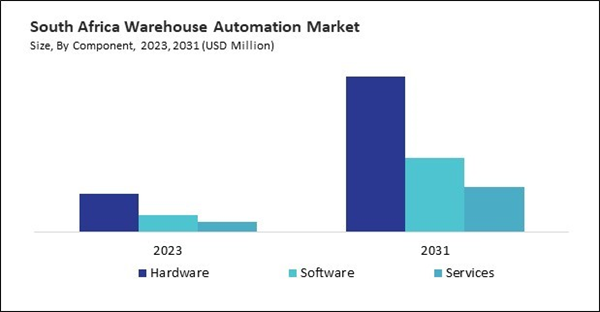The Brazil market dominated the LAMEA Warehouse Automation Market by Country in 2023, and would continue to be a dominant market till 2031; thereby, achieving a market value of $1.42 billion by 2031. The Argentina market is showcasing a CAGR of 22% during (2024 - 2031). Additionally, the UAE market would register a CAGR of 20.4% during (2024 - 2031).
Several key trends are shaping the future of warehouse automation, driven by technological advancements and evolving industry needs. Companies increasingly focus on sustainability in their supply chain operations, including warehouse management.
Moreover, this trend includes adopting practices such as reducing carbon footprints, minimizing waste, and optimizing energy use in warehouse operations. Sustainable practices are becoming a key consideration for businesses aiming to enhance their environmental responsibility and appeal to eco-conscious consumers.
The UAE’s focus on Industry 4.0 technologies, including IoT, AI, and robotics, promotes the integration of these technologies into warehouse automation. This enhances real-time data analytics, predictive maintenance, and warehouse autonomous operations. As per the International Trade Administration (ITA), In October 2021, the Abu Dhabi Department of Economic Development (ADDED) announced a new Smart Manufacturing initiative to diversify its economy and attract foreign companies. The UAE government’s initiatives like “UAE Vision 2021” and “Operation 300bn” aim to boost the manufacturing sector, emphasizing adopting smart technologies. These initiatives drive the demand for automated warehousing solutions to enhance operational efficiency and competitiveness.
Based on Component, the market is segmented into Hardware (Autonomous Robots (AGV, AMR), Automated Sorting Systems, Automated Storage & Retrieval Systems (AS/RS), De-palletizing/Palletizing Systems, Conveyor Systems, and Automatic Identification & Data Collection (AIDC)), Software (Warehouse Management System (WMS), Warehouse Execution Systems (WES), and Labor Management Systems (LMS)), and Services (Installation & Integration, Consulting, Training & Education, Maintenance & Support, and Analytics & Reporting Tools). Based on Level, the market is segmented into Intermediate Automation, Basic Automation, Advanced Automation, and Autonomous Warehouses. Based on Application, the market is segmented into Retail & E-commerce, Automotive, Aerospace & Defense, Healthcare, Electronics & Semiconductors, and Other Applications. Based on countries, the market is segmented into Brazil, Argentina, UAE, Saudi Arabia, South Africa, Nigeria, and Rest of LAMEA.
List of Key Companies Profiled
- Honeywell International, Inc.
- Murata Machinery, Ltd.
- Knapp AG
- ABB Group
- FANUC Corporation
- Kuka AG (Midea Group Co., Ltd.)
- Jungheinrich AG
- KION GROUP AG
- Daifuku Co., Limited
- Omron Corporation
Market Report Segmentation
By Component
- Hardware
- Autonomous Robots (AGV, AMR)
- Automated Sorting Systems
- Automated Storage & Retrieval Systems (AS/RS)
- De-palletizing/Palletizing Systems
- Conveyor Systems
- Automatic Identification & Data Collection (AIDC)
- Software
- Warehouse Management System (WMS)
- Warehouse Execution Systems (WES)
- Labor Management Systems (LMS)
- Services
- Installation & Integration
- Consulting, Training & Education
- Maintenance & Support
- Analytics & Reporting Tools
By Level
- Intermediate Automation
- Basic Automation
- Advanced Automation
- Autonomous Warehouses
By Application
- Retail & E-commerce
- Automotive
- Aerospace & Defense
- Healthcare
- Electronics & Semiconductors
- Other Applications
By Country
- Brazil
- Argentina
- UAE
- Saudi Arabia
- South Africa
- Nigeria
- Rest of LAMEA
Table of Contents
Companies Mentioned
- Honeywell International, Inc.
- Murata Machinery, Ltd.
- Knapp AG
- ABB Group
- FANUC Corporation
- Kuka AG (Midea Group Co., Ltd.)
- Jungheinrich AG
- KION GROUP AG
- Daifuku Co., Limited
- Omron Corporation
Methodology

LOADING...









